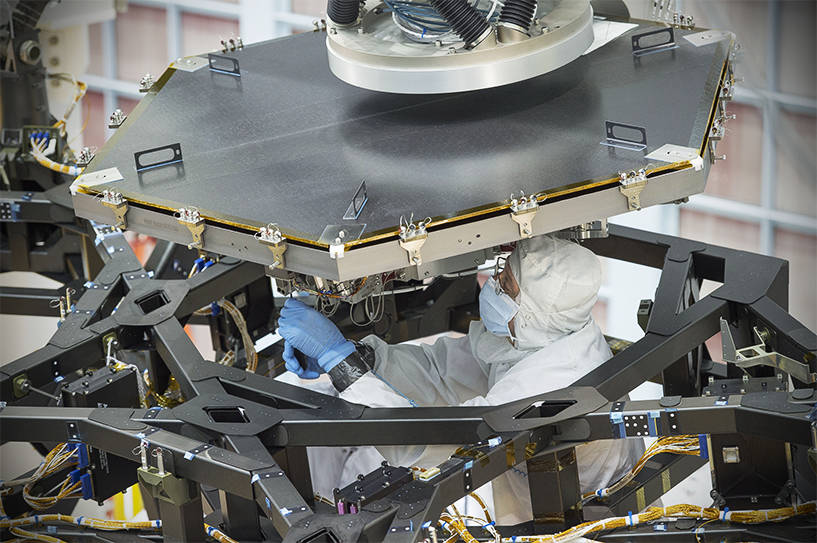
The James Webb Space Telescope (JWST) just took a big step toward reality with the successful installation of the first of its many flight mirrors. This is the critical beginning of the final phase of construction of the telescope, which will be the successor to the Hubble Space Telescope.
The mirror is the first of 18 primary mirror segments which will be installed in the space-based observatory.
“The James Webb Space Telescope will be the premier astronomical observatory of the next decade,” said John Grunsfeld, astronaut and associate administrator of the Science Mission Directorate at NASA Headquarters in Washington. “This first-mirror installation milestone symbolizes all the new and specialized technology that was developed to enable the observatory to study the first stars and galaxies, examine the formation stellar systems and planetary formation, provide answers to the evolution of our own Solar System, and make the next big steps in the search for life beyond Earth on exoplanets.”
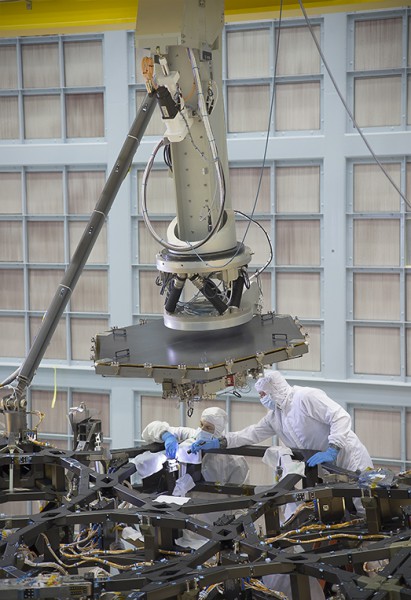
The installations are being done in the clean room at NASA’s Goddard Space Flight Center in Greenbelt, Md. The first mirror just installed measures just over 4.2 feet (1.3 meters) across and weighs approximately 88 pounds (40 kilograms). When all 18 mirrors are in place and functioning, they will act as one large 21.3-foot (6.5-meter) mirror. The installation process is expected to be completed early next year.
Each mirror segment will unfold and adjust its shape after launch, and are composed of ultra-lightweight beryllium which is known for its thermal and mechanical properties at cryogenic temperatures. Each segment can also reflect ultraviolet light using a thin coating of gold. The orbiting telescope also has a giant five-layered sunshield, about the size of a tennis court, which will attenuate heat from the Sun more than a million times.
The installation of the mirrors is an exciting time, since this is the final assembly phase before the telescope will be tested and then launched. The mirrors are a marvel of engineering, since they must remain precisely aligned at all times. The backplane must not move more than 38 nanometers, or about one-thousandth the diameter of a human hair. This is critical in the extremely cold temperatures of minus 406 and minus 343 degrees Fahrenheit that the telescope will experience.
“After a tremendous amount of work by an incredibly dedicated team across the country, it is very exciting to start the primary mirror segment installation process” said Lee Feinberg, James Webb Space Telescope optical telescope element manager at Goddard. “This starts the final assembly phase of the telescope.”
“There have many significant achievements for Webb over the past year, but the installation of the first flight mirror is special,” said Bill Ochs, James Webb Space Telescope project manager. “This installation not only represents another step towards the magnificent discoveries to come from Webb, but also the culmination of many years of effort by an outstanding dedicated team of engineers and scientists.”
The mirrors were built by Ball Aerospace & Technologies Corp., in Boulder, Colo. Ball is also the principal subcontractor to Northrop Grumman for the optical technology and lightweight mirror system. The installation of the mirrors is being done by Harris Corporation of Rochester, N.Y., which leads integration and testing for the telescope.
The mirror installation can be viewed live by webcam.
JWST is highly anticipated by astronomers, which is scheduled for launch in October 2018. It will study a wide variety of cosmic phenomena, including the first luminous glows from the early Universe, the evolution of our Solar System, and the formation of other solar systems which might be capable of supporting life on Earth-like planets.
More specifically:
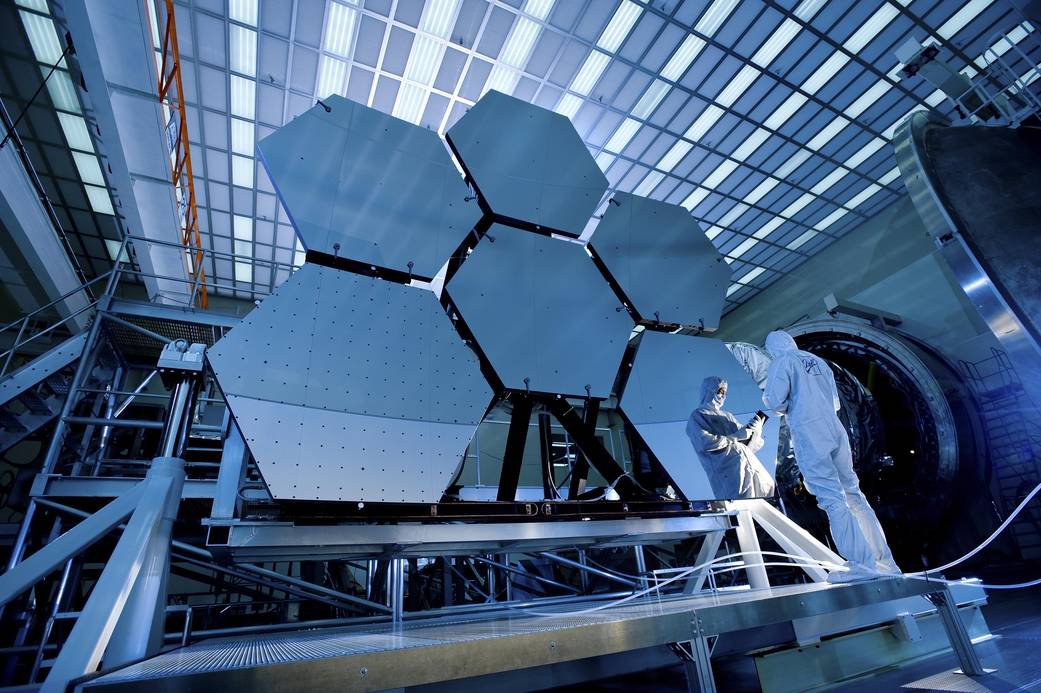
- The End of the Dark Ages: First Light and Deionization – JWST will be a powerful time machine with infrared vision that will peer back over 13.5 billion years to see the first stars and galaxies forming out of the darkness of the early universe.
- Assembly of Galaxies – JWST’s unprecedented infrared sensitivity will help astronomers to compare the faintest, earliest galaxies to today’s grand spirals and ellipticals, helping us to understand how galaxies assemble over billions of years.
- The Birth of Stars and Protoplanetary Systems – JWST will be able to see right through and into massive clouds of dust that are opaque to visible-light observatories like Hubble, where stars and planetary systems are being born.
- Planetary Systems and the Origins of Life – JWST will tell us more about the atmospheres of extrasolar planets, and perhaps even find the building blocks of life elsewhere in the universe. In addition to other planetary systems, JWST will also study objects within our own Solar System.
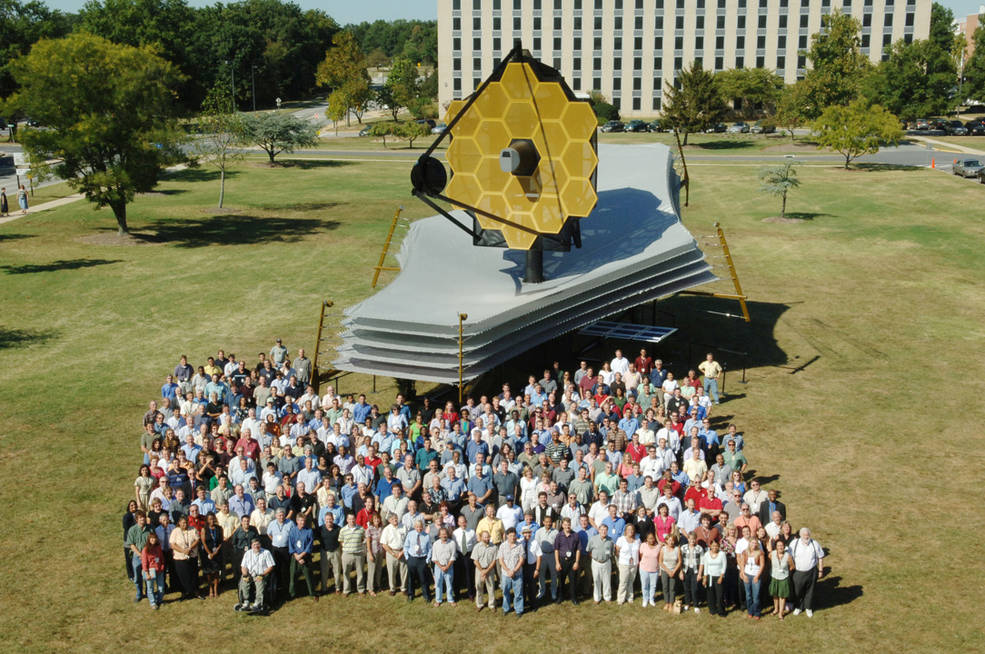
JWST will look for exoplanets transiting their stars and will also be able to directly image some larger exoplanets orbiting brighter stars by using coronagraphs. It will also be able to study the atmospheres of those exoplanets.
Instruments on the telescope include the Near-Infrared Camera (NIRCam), Near-Infrared Spectrograph (NIRSpec), Mid-Infrared Instrument (MIRI), and Fine Guidance Sensor/Near InfraRed Imager and Slitless Spectrograph (FGS/NIRISS).
Engineers also recently deployed the telescope’s “wings”—side portions of the backplane structure which fold up. The wings and telescope structure make up the telescope’s carbon fiber framework which will hold all 18 of the telescope’s mirrors as well as the tower for the primary mirror.
“The two wings of the telescope structure will eventually hold 6 of Webb’s 18 primary mirror segment assemblies,” said Adam Carpenter, Mechanical Integration Engineer at Goddard. “They are necessary so that the observatory can fold up in order to fit into the launch vehicle.”
JWST will be the premiere telescope of the next decade and will be used by thousands of astronomers worldwide. Formerly known as the “Next Generation Space Telescope” (NGST), it was renamed in September 2002 after a former NASA administrator, James Webb.
More information about the James Webb Space Telescope is available here. JWST is a joint project of NASA, the European Space Agency (ESA), and the Canadian Space Agency (CSA).
Be sure to “Like” AmericaSpace on Facebook and follow us on Twitter: @AmericaSpace
.
Missions » James Webb Telescope »



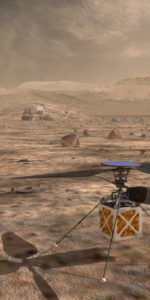
Great machine, can’t wait to see pictures. Great job guys.